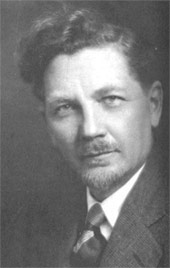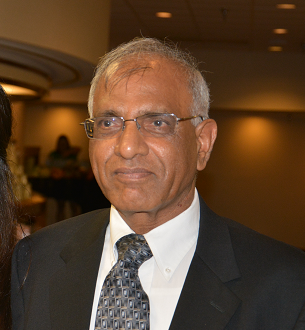Solid mechanics is the branch of continuum mechanics that studies the behavior of solid materials, especially their motion and deformation under the action of forces, temperature changes, phase changes, and other external or internal agents.

The Timoshenko Medal is an award given annually by the American Society of Mechanical Engineers (ASME) to an individual "in recognition of distinguished contributions to the field of applied mechanics."
Bernard Budiansky was an American scholar in the field of applied mechanics, and made seminal contributions to the mechanics of structures and mechanics of materials. He was a recipient of the Timoshenko Medal.

Warner Tjardus Koiter was an influential mechanical engineer and the Professor of Applied Mechanics at Delft University of Technology in the Netherlands from 1949 to 1979.
Applied mechanics is the branch of science concerned with the motion of any substance that can be experienced or perceived by humans without the help of instruments. In short, when mechanics concepts surpass being theoretical and are applied and executed, general mechanics becomes applied mechanics. It is this stark difference that makes applied mechanics an essential understanding for practical everyday life. It has numerous applications in a wide variety of fields and disciplines, including but not limited to structural engineering, astronomy, oceanography, meteorology, hydraulics, mechanical engineering, aerospace engineering, nanotechnology, structural design, earthquake engineering, fluid dynamics, planetary sciences, and other life sciences. Connecting research between numerous disciplines, applied mechanics plays an important role in both science and engineering.
John W. Hutchinson is the Abbott and James Lawrence Research Professor of Engineering in the School of Engineering and Applied Sciences at Harvard University. He works in the field of solid mechanics concerned with a broad range of problems in structures and engineering materials.
Raymond David Mindlin was an American mechanical engineer, Professor of Applied Science at Columbia University, and recipient of the 1946 Presidential Medal for Merit and many other awards and honours. He is known as mechanician, who made seminal contributions to many branches of applied mechanics, applied physics, and engineering sciences.
This is an alphabetical list of articles pertaining specifically to structural engineering. For a broad overview of engineering, please see List of engineering topics. For biographies please see List of engineers.
Paul Mansour Naghdi was a professor of mechanical engineering at University of California, Berkeley.
This is an alphabetical list of articles pertaining specifically to Engineering Science and Mechanics (ESM). For a broad overview of engineering, please see Engineering. For biographies please see List of engineers and Mechanicians.

Thomas Joseph Robert Hughes is a Professor of Aerospace Engineering and Engineering Mechanics and currently holds the Computational and Applied Mathematics Chair (III) at the Oden Institute at The University of Texas at Austin. Hughes has been listed as an ISI Highly Cited Author in Engineering by the ISI Web of Knowledge, Thomson Scientific Company.
James Robert Rice is an American engineer, scientist, geophysicist, and Mallinckrodt Professor of Engineering Sciences and Geophysics at the Harvard John A. Paulson School of Engineering and Applied Sciences.

Junuthula N. Reddy is a Distinguished Professor, Regent's Professor, and inaugural holder of the Oscar S. Wyatt Endowed Chair in Mechanical Engineering at Texas A&M University, College Station, Texas, USA.[1] He is an authoritative figure in the broad area of mechanics and one of the researchers responsible for the development of the Finite Element Method (FEM). He has made significant seminal contributions in the areas of finite element method, plate theory, solid mechanics, variational methods, mechanics of composites, functionally graded materials, fracture mechanics, plasticity, biomechanics, classical and non-Newtonian fluid mechanics, and applied functional analysis. Reddy has over 620 journal papers and 20 books and has given numerous national and international talks. He served as a member of the International Advisory Committee at ICTACEM, in 2001 and keynote addressing in 2014.[2][3]
Morton E. Gurtin was a mechanical engineer who became a mathematician and mathematical physicist. He was an emeritus professor of mathematical sciences at Carnegie-Mellon University, where for many years he held an endowed chair as the Alumni Professor of Mathematical Science. His main work is in materials science, in the form of the mathematical, rational mechanics of non-linear continuum mechanics and thermodynamics, in the style of Clifford Truesdell and Walter Noll, a field also known under the combined name of continuum thermomechanics. He has published over 250 papers, many among them in Archive for Rational Mechanics and Analysis, as well as a number of books.
Albert Edward Green was a British applied mathematician and research scientist in theoretical and applied mechanics.
Raymond William Ogden is a British applied mathematician. He is the George Sinclair Professor of Mathematics at the Department of Mathematics and Statistics of the University of Glasgow.
Lloyd Hamilton Donnell was an American mechanical engineer, and Professor of Mechanical Engineering at the Illinois Institute of Technology. He is considered internationally renowned expert in engineering mechanics, specifically known for his work on shell analysis and thin-shell structure. He was recipient of the 1969 ASME Medal.

Max Erich (Eric) Reissner was a German-American civil engineer and mathematician, and Professor of Mathematics at the Massachusetts Institute of Technology. He was recipient of the Theodore von Karman Medal in 1964, and the ASME Medal in 1988.
Henry Louis Langhaar was a mathematician, engineer, researcher, educator, and author in the field of engineering mechanics. In 1978, he retired as Professor Emeritus, after 31 years in the Department of Theoretical & Applied Mechanics (TAM) at the University of Illinois at Urbana-Champaign.
Wolfgang Gustav Knauss is an American engineer. He was Theodore von Kármán Professor of Aeronautics and Applied Mechanics at Caltech.